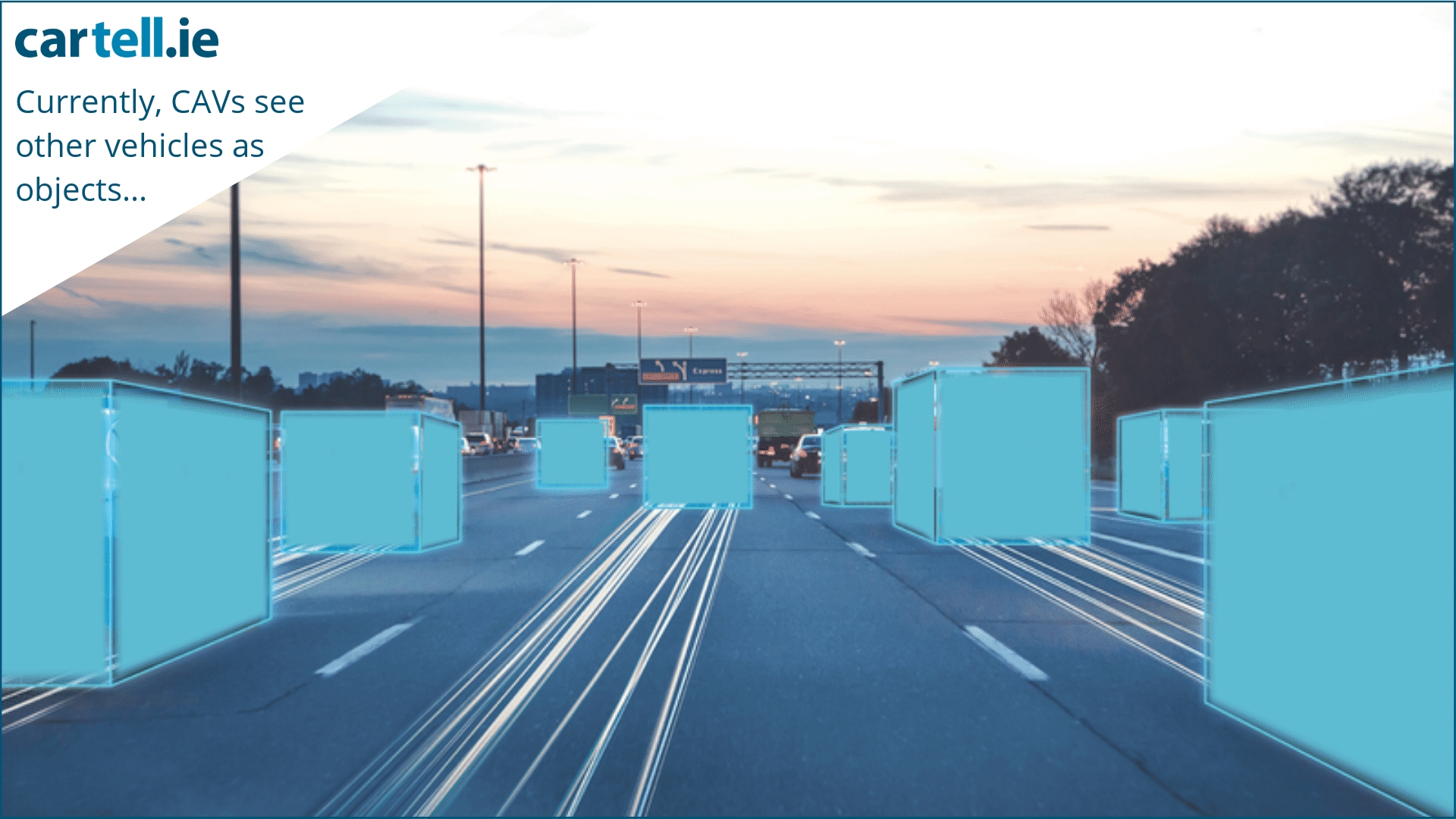ADASTRA © (Patent Pending*) is Cartell’s answer to a major problem that will face the automotive industry in the coming years.
At present, connected autonomous vehicles (CAVs) see other vehicles on the road as large or small objects. As humans we can easily tell the difference between a car, SUV, lorry and tractor and adjust our driving based on what is around us.
Cartell want the CAVs of the future to see each vehicle on the road as it is, just as a human does and to make driving decisions accordingly.

Levels 0f Autonomy/Automation
Level 0 vehicles have no driver assistance.
The driver is responsible for all operations of the vehicle and is required to pay full attention at all times.[/tab] [tab title=”Level 1″]Level 1 vehicles have simple advanced driver assistance systems. These systems will usually include Autonomous Emergency Braking (AEB), Lane Departure Warning Systems (LDW), Adaptive Cruise Control (ACC), Blind Spot Monitors (BLIS). These are just assistance systems.
The driver is still in full control of the vehicle and is always required to pay full attention.[/tab] [tab title=”Level 2″]Level 2 vehicles have more advanced driver assistance systems. These will include lane keeping aids that will actively steer the vehicle back into lane if it is straying, adaptive cruise control that will bring the vehicle to a complete stop and take off again, blind spot monitors that will steer the vehicle out of the path of an oncoming vehicle from the rear.
The driver is still in full control of the vehicle and is always required to pay full attention.[/tab] [tab title=”Level 3″]Level 3 vehicles are equipped with systems such as traffic jam assist. When these systems are active the car will be able to control the acceleration, braking and steering of the vehicle in certain situations.
The driver will be able to take their hands off the steering wheel for a short period of time but is still required to pay full attention.[/tab] [tab title=”Level 4″]Level 4 vehicles should be able to drive unassisted in most scenarios.
The driver of the vehicle should still be paying complete attention and be ready to take over at any time.[/tab] [tab title=”Level 5″]Level 5 vehicles should be able to drive unassisted in all scenarios.
There should be no need for a steering wheel or pedals in a level 5 vehicle.[/tab] [/tabs]
The Problem
How will Level 4 & Level 5 CAVs share the road with today’s driver dependent vehicles?
We all make different decisions based on other vehicles travelling around us. We will overtake a tractor on a road before overtaking a bus as we know the tractor can only travel at a maximum speed of 50 – 60 kph and that in every scenario our car has the power to pass that tractor safely. If an old car is travelling too close behind us on a wet day, we know this old car may not have the braking capabilities to stop in an emergency, so we pull out of the way.
Taking responsibility from the human to rely on a machine is the common cause for apprehension regarding CAVs. The main reason being, a machine does not see the world as a human does.
At present, L4 vehicles use cameras to identify objects around it including vehicles, cyclists and pedestrians. Radar sensors can be used for long distance recognition and speed measurement, while Lidar sensors are used to map the surrounding area – generating a 3D image.
These sensors work together and allow for greater depth of driver assistance but the vehicle remains unable to have awareness of what surrounds it, as a human would.
ADASTRA © will allow CAVs to see a bus as a bus, instead of a large moving object. A small city car will be seen as a small city car, instead of a small object. Current L4 vehicles can’t see these differences.
The current L4 CAVs cannot make decisions based on the vehicles around it. The current L4’s see them as objects rather than what they are.
ADASTRA © – The Solution
For L4 and L5 CAVs to safely use the roads with L0 to L3 vehicles, they should be fully aware of the surrounding vehicle’s particular characteristics.
L4 CAVs will be pre-loaded with the data of all live vehicles in the country. This will happen before it goes out on the road and can be instantly updated over the air.
ADASTRA © (patent pending) is a system capable of determining the attributes of vehicles around it. Using the ADASTRA © system, the L4 now knows every detail of the surrounding vehicles. It will be able to tell the difference between a L2 2018 Scania R620 to its right, a L0 2009 VW Golf behind it, a L1 2015 Mercedes S Class in front of it and a L3 2023 Audi A8 to its left. It knows the make, model, weight, dimensions, ADAS, stopping distance, power and more.
L4 and L5 cars will use ADASTRA © to adapt its driving in particular situations, just as a human would.
There are multiple use cases to demonstrate how ADASTRA © will make driving a simpler and safer experience.
Cartell believe ADASTRA © will rapidly accelerate the introduction of Connected Autonomous Vehicles. Thus, making our roads a safer place for everyone.
*(United Kingdom, Application No 1804972.6) (International (PCT) Application No PCT/EP2019/052204: title: “Method and System for Determining Advanced Driver Assistance Systems (ADAS) Features”)